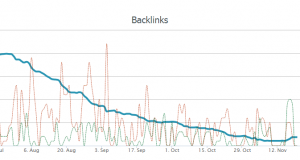
Checking the Content
Before digging into your link profile, check the elements that both readers and search engine crawlers can see. Examine your client’s website for keyword stuffing – check how many times their content mentions an exact keyword, and if its occurrence in the text is natural. There’s a thin line between mentioning keywords enough and having too much of them on a page, and you have to be very careful when assessing your client’s site.
Make sure to check for other things like duplicate content and outdated information. Some websites repeat topics in an effort to rank for specific keyword variations, and do not realize they have a similar page already. Most importantly, assess the quality of their content. Is it fresh enough to keep their audience engaged, and relevant enough to their industry?
The Solution: Quality Writing

If you still want a formula for your keyword mentions, take various anchor text studies done in the past, like the one on Search Engine Journal. According to this study, if you use 60% branded, non-targeted anchor texts and 40% partial or exact match non-branded anchor texts, you’ll be in good shape.
Analyzing the Link Profile

1. Your referring domain / external backlink ratio
Make sure this is above 30%. This is readily available when you click “explore” on your site explorer tool of choice.
2. Your anchor text / total back links ratio
Go to the domain level report on your site explorer, and select to create a detailed anchor text report. Download this as a CSV file, and get the columns with your anchor texts and total backlinks. Divide these to get your AT/TBL ratio. See which keywords display a higher ratio compared to the rest. These are your over-optimized pages.
3. The quality of your back links
See where most of your inbound links are coming from. They should come from a wide variety of domains. Examine which pages are not contributing anything to your client’s site, or which ones are hurting your client’s rankings. You may receive a back-link from a site that was penalized for over-optimization or for engaging in practices frowned upon by search engines. This could get your client’s site in trouble.
The Solution: Target, Diversify, Clean

Next, you need to target specific audiences and create content that connects with each audience group. Keep your client’s branding consistent, and highlight the features most relevant to each segment. Consistent branding helps you come up with the 60% branded keywords you will use, and it helps get a more diverse audience talking. It prevents over-optimization and helps build a more diverse link profile at the same time.
Finally, clean your link profile. If you notice any over-optimized pages when you examine the AT/TBL ratio, try and reduce the number of anchor texts in each page. Get in touch with the owners of the low-quality websites and have them take down your link from their site. You can also submit these websites to Google to exclude from your link profile. Avoid using site-wide links in your clients’ websites as well – search engines may read this as spam.
Contact your account manager today for more tips and get started with your site audits. If you’re not yet our partner, create a free account now. Keep checking back for more tips and updates!

